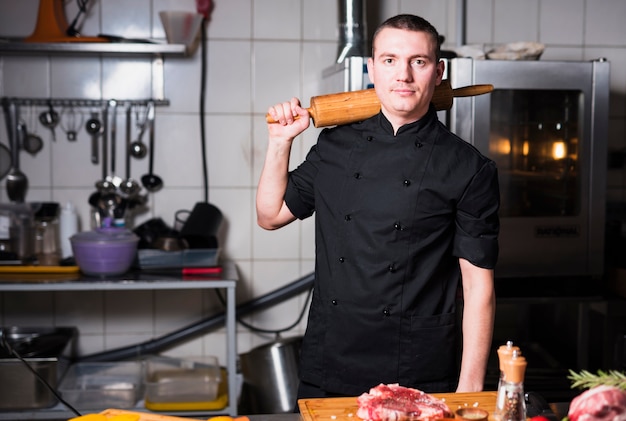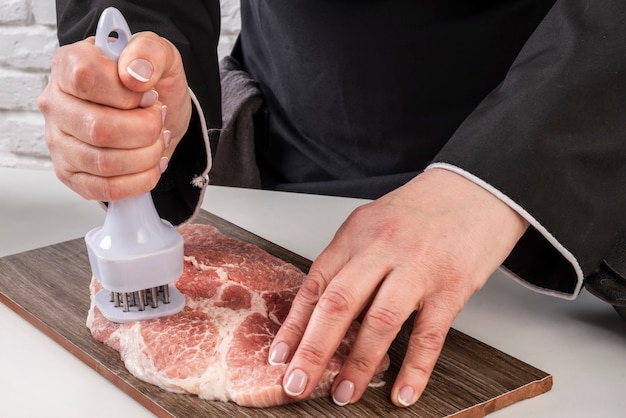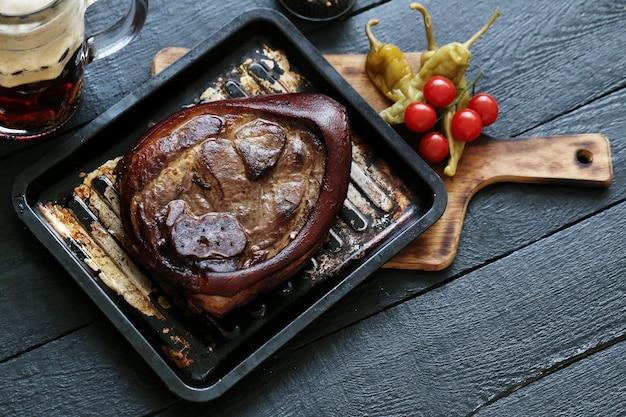Ah, the humble steak. A timeless classic, a culinary masterpiece, and a source of endless debate. Rare, medium-rare, medium, medium-well, well-done – everyone has their preference. But whether you're a seasoned grill master or a novice cook, knowing the perfect internal temperature is crucial for achieving that succulent, melt-in-your-mouth steak experience.
I've been a steak enthusiast for as long as I can remember. I've spent countless hours experimenting in the kitchen, trying out different cuts, cooking methods, and seasonings. I've had my share of triumphs, but also my fair share of disasters. But through it all, I've learned that using a meat thermometer is the ultimate key to consistency. It's your secret weapon, your culinary compass, and it's the only way to ensure your steak is cooked to your exact preference every single time.
Part 1: Understanding Internal Temperatures

Why Does Internal Temperature Matter?
You might be thinking, "I can tell by the colour if my steak is cooked right, why do I need a thermometer?" Well, hold on a minute. The colour of a steak can be deceiving. It can vary depending on the cut, the thickness, and even the lighting in your kitchen. A thick ribeye might appear quite red even when cooked to medium, while a thinner steak could seem brown and cooked even when it's still rare.
The only way to guarantee your steak is cooked to your desired level of doneness is to use a meat thermometer. It's the single most important tool for achieving that perfect bite, ensuring that it's not undercooked or, heaven forbid, overcooked.
What is the Ideal Internal Temperature Range?
Each level of doneness has a specific internal temperature range, and once you understand these, you'll be on your way to steak perfection:
| Doneness | Internal Temperature (°F) | Internal Temperature (°C) |
|---|---|---|
| Rare | 125-130°F | 52-54°C |
| Medium-Rare | 130-135°F | 54-57°C |
| Medium | 135-140°F | 57-60°C |
| Medium-Well | 140-145°F | 60-63°C |
| Well-Done | 145°F and above | 63°C and above |
Remember, these are just guidelines. Some people prefer their steaks a few degrees higher or lower. The important thing is to find the internal temperature that you enjoy.
Choosing the Right Thermometer
The world of meat thermometers can seem overwhelming, but don't worry, it's not as complicated as it seems. The most reliable and user-friendly option is a digital instant-read thermometer. These handy devices are fast, accurate, and easy to use, making them perfect for both experienced cooks and those just starting out.
You can find them at most kitchen stores, supermarkets, or online. They are affordable and a worthwhile investment for anyone who loves to cook steak (or any other meat, for that matter!).
To use your thermometer correctly, insert it into the thickest part of the steak, making sure to avoid any bones or fat. You want to get a reading from the heart of the steak, not from the outer edges.
Part 2: cooking techniques

Now that you're armed with the knowledge of internal temperatures and a trusty thermometer, it's time to delve into the exciting world of cooking techniques.
pan-seared steak: The Classic Approach
This is the ultimate technique for achieving a crispy crust and a juicy, flavorful interior. It's simple, versatile, and always impressive. Here's how to pan-sear a steak like a pro:
- Pat Dry: Start by patting your steak dry with paper towels. This will help the steak sear properly and achieve a beautiful, crispy crust.
- Season Generously: Don't be shy with the salt and pepper! Season your steak liberally on both sides. You can also add other spices like garlic powder, onion powder, or paprika, depending on your taste.
- Heat Up the Pan: Grab your heaviest cast iron pan or a good quality skillet. Heat it over high heat until it’s smoking hot. This is crucial for achieving a perfect sear.
- Add the Steak: Carefully place your steak in the hot pan and don’t move it for at least 3 minutes. Let it sit undisturbed, allowing the steak to form a delicious crust. You might hear a delightful sizzle as it hits the pan.
- Flip It: After 3 minutes, carefully flip the steak and cook for another 3 minutes on the other side. Adjust the cooking time based on the thickness of the steak and your desired doneness.
- Check the Temperature: Use your trusty thermometer to check the internal temperature. If it's not quite there yet, cook for another minute or two, checking again.
- Rest, Rest, Rest: Once the steak is cooked to your liking, remove it from the pan and place it on a cutting board. Cover it loosely with foil and let it rest for 5-10 minutes. This allows the juices to redistribute throughout the steak, resulting in a more tender and flavorful experience.
grilled steak: Summertime Delights
Grilled steak is synonymous with warm summer evenings, backyard barbecues, and the aroma of smoky goodness. It's a simple yet satisfying technique that can elevate any meal. Here's how to grill a steak like a champion:
- Preheating Power: Preheating your grill is crucial. If you're using charcoal, wait until the coals are white-hot before placing your steak on the grill. For gas grills, preheat to medium-high heat.
- Seasoning is Key: Pat your steak dry and season generously with salt, pepper, and any other spices you love.
- Get the Sear: Place the steak on the hot grill and cook for 3-4 minutes per side, or until you have a nice sear. This will give your steak those beautiful grill marks.
- Even Cooking: Move the steak to a cooler part of the grill, or reduce the heat, to continue cooking. This will help ensure the steak cooks evenly and doesn't overcook.
- Temperature Check: Use your thermometer to check the internal temperature frequently. Cook until it reaches your desired doneness.
- Rest Time: Once the steak is cooked, remove it from the grill and let it rest for 5-10 minutes before slicing and serving.
Oven-Roasted Steak: Effortless Elegance
Oven-roasting steak is a great option if you want a more hands-off approach. It's perfect for cooking multiple steaks at once, making it ideal for dinner parties or large gatherings. Here's how to roast a steak like a pro:
- Preheat the Oven: Preheat your oven to 400°F (200°C).
- Seasoning Magic: Season your steak generously with salt, pepper, and any other spices you like.
- Prepare the Baking Sheet: Place the steak on a baking sheet or in a roasting pan.
- Roast Time: Roast the steak for 10-15 minutes, depending on the thickness of the steak and your desired doneness.
- Internal Temperature: Use your trusty thermometer to check the internal temperature, and continue roasting until it reaches your desired temperature.
- Rest Time: Remove the steak from the oven and let it rest for 5-10 minutes before slicing and serving.
Part 3: The Importance of Resting

One of the most common mistakes people make when cooking steak is not resting it after cooking. This crucial step is often overlooked, but it’s absolutely essential for achieving a perfectly tender and flavorful steak.
When you cook a steak, the heat causes the muscle fibers to contract and the juices to move towards the center. When you immediately cut into the steak, you lose those precious juices, leaving you with a dry, tough piece of meat. But if you let the steak rest for 5-10 minutes (depending on the thickness), those juices have time to redistribute back throughout the steak, resulting in a more tender and flavorful experience.
To rest your steak, place it on a cutting board and cover it loosely with foil. Let it rest for at least 5-10 minutes before slicing. The longer you let it rest, the better.
Part 4: choosing the right cut
Not all steaks are created equal. Different cuts of beef have different levels of marbling, tenderness, and flavor, and they'll cook differently as well. Here's a quick guide to some popular steak cuts, so you can choose the perfect one for your next culinary adventure:
- Rib-eye: The king of steaks. This cut is known for its abundant marbling, which gives it a rich, buttery flavor and makes it incredibly tender. It's perfect for grilling, pan-searing, or broiling.
- new york strip: A classic choice for steak lovers. It's leaner than ribeye but still has a good amount of marbling, giving it a flavorful and tender texture. It's great for grilling, pan-searing, or broiling.
- Sirloin: A versatile cut that's a bit leaner than ribeye or strip but still very flavorful. It's perfect for grilling, pan-searing, or roasting.
- filet mignon: The epitome of luxury. This is the most tender cut of beef, known for its delicate flavor. It's best cooked medium-rare to medium and is perfect for grilling, pan-searing, or broiling.
- flank steak: A tougher cut of meat but also very flavorful. It's ideal for grilling, stir-frying, or marinating, as it benefits from longer cooking times.
Part 5: Seasoning and Marinades
The right seasoning can transform a simple steak into a culinary masterpiece. Salt and pepper are the classic duo, but don't be afraid to experiment with other spices and herbs to elevate your steak to the next level.
Here are some ideas for adding extra flavor to your steak:
- Garlic Powder and Onion Powder: These spices add a savory depth of flavor.
- Paprika: A touch of paprika can add a subtle smokiness to your steak.
- Chili Powder: If you like things a bit spicier, a sprinkle of chili powder can give your steak a fiery kick.
- Rosemary, Thyme, or Oregano: Fresh herbs add a beautiful aroma and a hint of freshness.
Marinades can also be a game-changer for your steak. They not only add flavor but can also help to tenderize the meat. A simple marinade of olive oil, lemon juice, garlic, and herbs can work wonders. For a sweeter flavor, try adding soy sauce, balsamic vinegar, or honey.
Remember to marinate your steak for at least 30 minutes, or even up to 24 hours for maximum flavor penetration.
Part 6: Elevate Your Steak with Sauces
No steak is complete without a delicious sauce to complement its rich flavors. From classic to contemporary, there's a sauce out there for every taste bud. Here are some classic steak sauces that are sure to impress:
- Béarnaise Sauce: This rich and creamy sauce is made with egg yolks, butter, and tarragon. It's perfect for serving with filet mignon or ribeye.
- Mushroom Sauce: This earthy and savory sauce is made with mushrooms, butter, and cream. It's a delicious accompaniment to any steak, but it's especially good with sirloin or flank steak.
- Red Wine Sauce: This classic and flavorful sauce is made with red wine, beef broth, and shallots. It's perfect for serving with any steak.
- Peppercorn Sauce: This simple but flavorful sauce is made with peppercorns, butter, and cream. It's a great option for adding a spicy kick to your ribeye or sirloin.
- Garlic Butter Sauce: This simple and flavorful sauce is made with butter, garlic, and herbs. It's a perfect pairing for any steak.
Part 7: Completing Your Steak Experience with Sides
No steak is complete without a great side dish to complement its flavors and create a well-balanced meal. Here are some classic steak side dishes that are sure to please:
- Roasted Potatoes: Crispy on the outside, fluffy on the inside. Roasted potatoes are a timeless classic that pairs perfectly with steak.
- Asparagus: Roasted, grilled, or steamed, asparagus adds a bright and fresh flavor to your meal.
- green beans: A simple yet delicious side dish that pairs well with steak. Try them steamed, roasted, or sautéed.
- Macaroni and Cheese: Creamy, cheesy, and comforting, macaroni and cheese is a classic side dish that pairs well with steak.
- Creamed Spinach: A creamy and decadent side dish that’s perfect for steak.
Part 8: FAQs
1. What happens if I overcook my steak?
Overcooked steak is a culinary tragedy. It becomes tough, dry, and loses its juicy flavor. The longer you cook a steak, the more moisture it loses. To avoid this, use your meat thermometer to check the internal temperature and don't cook it beyond your desired doneness.
2. How can I tell if my steak is done without a thermometer?
While you can try to gauge doneness by the color of the steak, it's not a reliable method. Different cuts of steak can appear cooked differently, even when they are at the same internal temperature. The only way to be sure is to use a meat thermometer.
3. How long should I rest my steak before slicing?
It’s always a good idea to rest your steak for at least 5-10 minutes before slicing. This allows the juices to redistribute, resulting in a more tender and flavorful steak.
4. Can I cook a steak from frozen?
It's possible, but it's not recommended. Frozen steak will take longer to cook and may not cook evenly. It’s always best to thaw your steak in the refrigerator overnight before cooking.
5. What if my steak isn't cooked to my liking?
If your steak isn’t cooked to your liking, you can always cook it a little bit more or a little bit less. But be careful not to overcook it. And remember, you can always try again next time. Practice makes perfect, and with a little patience and a meat thermometer, you'll be a steak-cooking pro in no time!
Everyone is watching

How to Cook Frozen Lobster Tails Perfectly: A Step-by-Step Guide
RecipesLobster. Just the word conjures up images of lavish meals, special occasions, and a taste of luxury. But let's...

Pigs in a Blanket Cooking Time: How Long to Bake for Perfect Results
RecipesAh, pigs in a blanket. Just the name conjures up images of those delightful little parcels of crispy pastry en...

Pork Fillet Cooking Time: How Long to Cook It Perfectly
RecipesPork fillet, or tenderloin as it's sometimes called, is a real favourite in our house. It's so versatile, and...

The Ultimate Guide to Cooking Delicious Frankfurters
RecipesLet's face it, we all love a good frankfurter. It's a classic, simple, and always satisfying. But let's be rea...

Wolf Meat Recipes: A Guide to Cooking Wild Game
RecipesLet's be honest, you don't see wolf meat at your local butcher shop every day. It's a bit of a wild card, but ...
